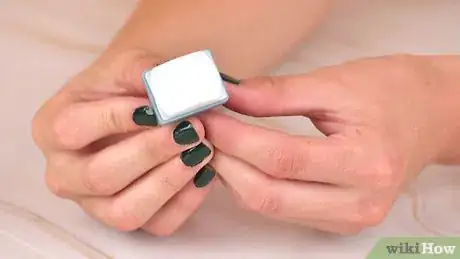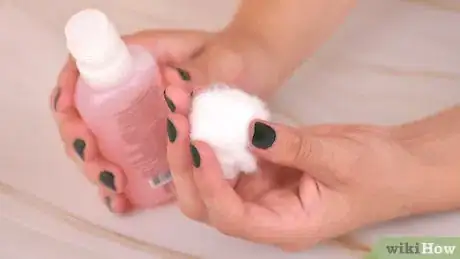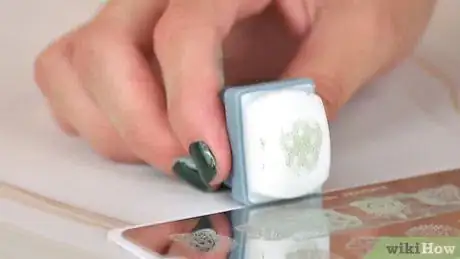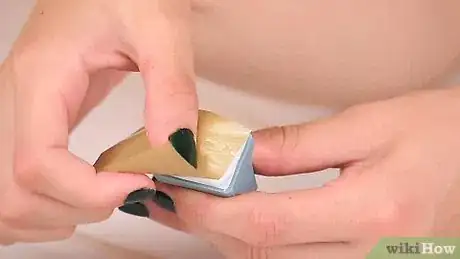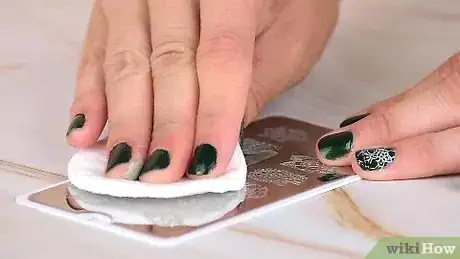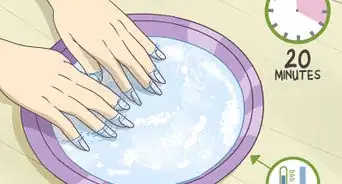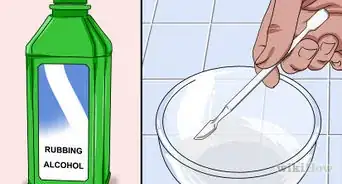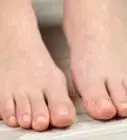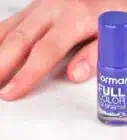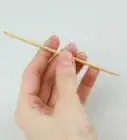This article was co-authored by wikiHow staff writer, Christopher M. Osborne, PhD. Christopher Osborne has been a wikiHow Content Creator since 2015. He is also a historian who holds a PhD from The University of Notre Dame and has taught at universities in and around Pittsburgh, PA. His scholarly publications and presentations focus on his research interests in early American history, but Chris also enjoys the challenges and rewards of writing wikiHow articles on a wide range of subjects.
There are 7 references cited in this article, which can be found at the bottom of the page.
The wikiHow Video Team also followed the article's instructions and verified that they work.
This article has been viewed 14,784 times.
Learn more...
Using a nail stamper is an easy way to transform simple polished nails into fun pieces of fingernail art! To get the stamps to apply smoothly and evenly, though, good preparation is critical. Take the time to clean and prep your stamper head and stamping plate the right way so you can get the nail stamp results you’re looking for.
Steps
Cleaning a Clear Gel Stamper
-
1Pull your new gel stamper’s head from its cylinder with your fingers. The soft, clear gel stamper head should pop right out of the clear plastic cylinder with minimal effort. Use your fingernail to get under the edge of the stamper head if necessary, but be careful not to slice into it with your nail.[1]
- Clear gel stampers are increasingly popular because they let you look straight down through the cylinder and see where you’re stamping on your fingernail!
-
2Wash off oily residue on the stamper head with soap and water. Place the stamper head in a bowl of clean water mixed with a squirt of dish soap. Gently but thoroughly rub all surfaces of the stamper head with your fingers.[2]
- New stamper heads usually have an oily residue on them due to the manufacturing process. If you don’t clean off this residue, your stamps won’t transfer to your nails properly.
- Do not clean clear gel stamper heads with pure acetone. The clear gel will get cloudy and start to break down. Soapy water is fine for the first cleaning, while alcohol and acetone-free nail polish remover work well to clean off polish residue after use.
Advertisement -
3Rinse off all the soap and residue with clean water. One option is to dunk the stamper head in a separate bowl of clean water and rub it with your fingers. The other alternative is to hold it under running water for 5-10 seconds.[3]
-
4Pat the stamper head completely dry with a lint-free towel. Use a cloth or paper towel to lightly dab the stamper head and remove all surface moisture. Once it’s fully dry, the stamper head is ready for use—just pop it back into the cylinder![4]
- If you chose the wrong drying cloth and got lint stuck all over the stamper head, rinse the lint away under clean water and dry the stamper head with a different cloth.
Cleaning a Non-Gel Stamper
-
1Rub the “squishy” head of your new stamper lightly with a nail buffer. Hold the stamper’s cylinder and keep the stamper head in place. Buff the stamper head gently with your nail buffer, using back-and-forth strokes. If you’re creating more than a very small amount of powdery residue, you’re buffing too hard![5]
- Lightly buffing the rubbery stamper surface removes oils left behind during the manufacturing process.
- Traditional, “squishy” stamper heads are not see-through like the newer clear gel heads. They can be a little tougher to get the hang of using at first, but they’re just as effective and more durable than clear gel stampers.
-
2Saturate a cotton ball with pure acetone. Pour about a capful of 100% acetone into a small bowl—make your best estimate of the amount it will take to fully saturate a single cotton ball. Drop in the cotton ball and let it soak up as much of the acetone as it can hold.[6]
- Use 100% acetone here, not nail polish remover that contains some amount (and perhaps no amount) of acetone. Look for pure acetone for sale alongside nail polish removers.
- Acetone is very flammable, so keep it well away from any open flames. Do not inhale more of the acetone fumes than is necessary to complete your task.
-
3Clean off the oil and residue on the stamper head with the cotton ball. Pick up the acetone-soaked cotton ball and use it to wipe away any powdery residue and excess oil on the stamper head. The stamper is ready for use as soon as the acetone dries, which doesn’t take long at all.[7]
Loading the Stamper Plate
-
1Wipe down the metal stamper plate with pure acetone. Add about a capful of 100% acetone to a small bowl and soak it up with a cotton ball. Use the saturated cotton ball to clean the plate, focusing especially on the “nooks and crannies” where dried polish may have collected. Let the stamper plate dry for 30-60 seconds before using it.[8]
- Do this before each use, including the first time you use the plate.
- Nail stamper plates have 4 or more stamp patterns (things like stripes, balloons, hearts, and so on) etched into their surface. To get a clean stamp on your fingernail, you need to remove any dried polish from these etchings.
- Good-quality nail stamper plates are made of metal and can stand up to regular cleanings with pure acetone. However, check your nail stamper kit’s product guide for specific cleaning instructions, especially if you have a non-metal stamper plate.
-
2Brush a generous amount of stamping polish onto your chosen pattern. Add enough stamping polish to the plate so that it completely fills in the etching of the stamp pattern you want to use, and also covers the flat surface of the plate surrounding your chosen etching. You don’t need to cover the entire plate and all the etchings, though—just the one you’re going to use right now![9]
- Stamping polish, which (as the name indicates) is specifically designed for nail stamping, offers the best results here. Alternatively, you can use a trial-and-error approach with other polishes, including gel polishes. Generally speaking, thicker polishes that provide single-coat coverage work best. In fact, old polish that has started to thicken can work here!
-
3Scrape off excess polish from the plate with a scraper or credit card. Use the scraper that comes with the kit or an old gift/credit card (which some nail stamping enthusiasts actually prefer). Hold it at a 45-degree angle to the plate surface and scrape it firmly across the plate with a single swipe. The goal is to leave behind all the polish in the etching and wipe away all the polish on the flat surface of the plate.[10]
- Wipe off the edge of your scraper with a cotton ball and make another scraping pass if there’s still some polish on the plate’s surface.
- Move on to loading the stamper head and applying the stamp to your fingernail right away. Don’t allow the polish to start drying in the etching, or it will be really tough to clean out when you’re done!
Applying a Stamp
-
1Roll the stamper head over the polish-filled pattern on the plate. Hold the stamper by the cylinder so that the stamper head is at about a 45-degree angle to the surface of the plate. Touch the edge of the stamper head to the plate just to the side of the etched, polish-filled stamp pattern. Press the stamper head down onto the pattern and lift it off with a single rolling motion—picture the feet of a rocking chair making contact with the floor while you rock forward.[11]
- Don’t press straight down and pull straight up—the stamp pattern will smear on the stamper head.
- You may have to practice this move a few times before you get it right—and that’s okay!
-
2Confirm that the stamp pattern looks good on the stamper head. If you’re using a clear gel stamper, simply look down through the clear cylinder. With a traditional stamper, flip it over and take a look at the transferred pattern on the head. If it looks right, you’re good to go![12]
- If the pattern didn’t transfer well, skip ahead a few steps to the instructions for cleaning off the stamper head. Then try again!
-
3Press the stamp onto your nail, using the same rolling motion as before. Line up the stamp over your nail, once again holding the stamper at a 45-degree angle. Slowly press and roll the stamp over your nail. Admire your new nail stamp after you lift the stamper away![13]
- While you can apply stamps to bare nails, you’ll get the best results by first applying a clear base coat and 1-2 coats of polish to your nails. Make sure to allow each of these coats to dry before proceeding.
- If the stamp doesn’t look right, quickly wipe it away with a damp cotton ball and try again.
-
4Protect your nail stamp by brushing on a clear top coat layer. Wait a couple of minutes until the stamp has fully dried, then brush on the top coat as normal. Once it dries, you’ll almost be ready to show off your stamped nails—after you do some quick cleanup![14]
-
5Clean the stamper head with packing tape or a sticky lint roller. Rip off a strip of packing tape, stick it to a lint-free cloth, and pull it off to reduce its stickiness a bit. Press the stamper down firmly onto the tape and pull it away. This should remove all the nail polish from the stamper head.[15]
- Instead of packing tape, try a lint roller that uses tear-away strips of tape—you don’t need to “de-stick” these any beforehand!
- If you can’t get all the polish off of the stamper head, wipe it with a cotton ball dipped in a bit of rubbing alcohol or nail polish remover. Do not use 100% acetone on a clear gel stamper head.
-
6Wipe the remaining polish from the plate with a cotton ball and acetone. When you’re all done stamping, soak a cotton ball in pure acetone and use it to wipe off all the polish residue on the stamping plate. Don’t allow the polish to harden in the pattern etchings, or it will be really tough to remove![16]
Warnings
- To be extra safe, hold your used, acetone-soaked cotton balls under running water for a few seconds. Squeeze them out and throw them in the trash.⧼thumbs_response⧽
Things You’ll Need
- Nail stamper kit
- Cotton balls
- Lint-free cloth or paper towel
- Pure acetone (100%)
- Nail polish remover
- Rubbing alcohol (optional)
- Dish soap
- Nail buffer
- Stamper polish or thick nail polish
- Packing tape or sticky lint roller
- Pre-polished nails (recommended)
References
- ↑ https://youtu.be/XB1ygCuuJ1Y?t=90
- ↑ https://youtu.be/XpT1SEGYJ9c?t=40
- ↑ https://youtu.be/XpT1SEGYJ9c?t=40
- ↑ https://youtu.be/XB1ygCuuJ1Y?t=90
- ↑ https://youtu.be/XB1ygCuuJ1Y?t=40
- ↑ https://www.goodhousekeeping.com/beauty/nails/a31930661/how-to-remove-gel-nail-polish/
- ↑ https://youtu.be/XB1ygCuuJ1Y?t=40
- ↑ https://easynailtech.com/clean-stampers-plates/
- ↑ https://www.raegunramblings.com/how-to-stamp-nails-tips-and-tricks-for-success/
- ↑ https://www.nailitmag.com/nail-tools-what-you-need-and-how-to-use-them
- ↑ https://www.nailitmag.com/nail-tools-what-you-need-and-how-to-use-them
- ↑ https://www.raegunramblings.com/how-to-stamp-nails-tips-and-tricks-for-success/
- ↑ https://www.nailitmag.com/nail-tools-what-you-need-and-how-to-use-them
- ↑ https://www.raegunramblings.com/how-to-stamp-nails-tips-and-tricks-for-success/
- ↑ https://www.nailitmag.com/nail-tools-what-you-need-and-how-to-use-them
- ↑ https://easynailtech.com/clean-stampers-plates/
